Daniel Austin is a Madagascar specialist and author of Bradt’s guidebooks and wildlife guide to this fascinating Indian Ocean island. He visits Madagascar regularly to lead small-group wildlife tours and he also lectures on expedition cruise ships when they are visiting that part of the world. Daniel is also secretary of the Anglo-Malagasy Society and founder of the Madagascar Library, an archive of some 6,000 books and documents about the island.
Here, in his own words, is an insight into some of Madagascar’s most easily overlooked miniature wonders.
Despite having been to Madagascar more than 20 times – often for several months at a time – I still constantly discover new things on my travels around this huge and diverse country. For me, it is an endlessly fascinating place in terms of landscape, people, culture, geology, flora and fauna, but it’s the last of these that’s the jewel in Madagascar’s crown. Everyone knows the island is a special wildlife destination, but make no mistake: despite being just off the African coast, wildlife experiences here couldn’t be further from the safaris that have become synonymous with the mainland.
There exists nothing on Madagascar as in-your-face as elephants and giraffes. Hippos and rhinos would dwarf even the largest animal Madagascar has to offer. Indeed, there’s barely a creature you couldn’t pick up and fit comfortably in your backpack – and you might be tempted to do just that when you see how beautiful some of them are! Madagascar is an island of subtlety; it is a destination for the photographer with a macro lens.
Mouse lemur
Let’s start with our closest relatives: the primates. Primate diversity in Madagascar is second to none. Worldwide, there are more than 500 primate species spread across 100 countries, and almost a quarter of those are found only in Madagascar. These are the lemurs, made famous by King Julien, who likes to move it move it.
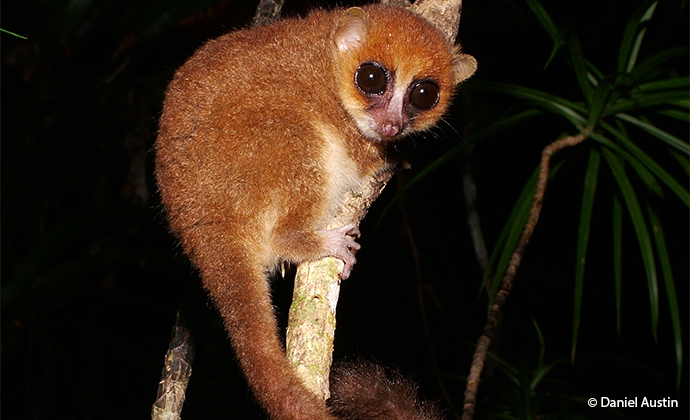
None of the lemurs are particularly huge (even the largest weighs little more than a domestic cat) but the smallest are astonishingly small. The appropriately named mouse lemurs, of which there are currently 24 described species, can be as tiny as 30g fully grown.
Baby red-fronted lemur
Lemurs are undeniably cute, so it’s no surprise that their diminutive babies are even cuter and melt the hearts of many a tourist visiting Madagascar’s forests. In most species, the young are carried on the mother’s belly or back for at least a few weeks after being born. Sometimes they disappear so deeply into her fur that, at first, you might not notice she is carrying a baby at all.
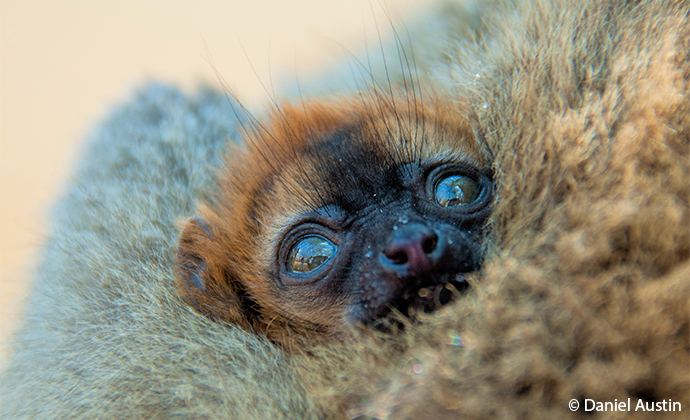
I took this photo of a little red-fronted lemur clinging on to his mother at Kirindy Reserve in the west of Madagascar.
Stump-tailed chameleon
It’s not just primates for which Madagascar holds size and diversity world records. There are 213 species of chameleon globally, and a staggering 92 of those are endemic to Madagascar – including the longest, the heaviest, and the smallest!
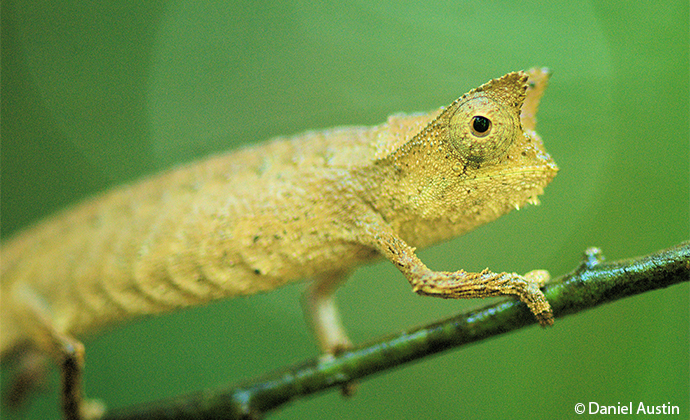
Those smallest ones are particularly curious beasts. Known scientifically as Brookesia, and in English either as stump-tailed or leaf chameleons, some species are no bigger than your thumbnail. That’s right: a reptile that is significantly smaller than some species of ant! It is quite remarkable to see these miniscule creatures in the flesh and marvel that, somehow, squeezed inside this tiny package is a heart and lungs, kidneys and liver, intestines and tongue, and all the other organs one would find in any larger reptile.
Madagascar day gecko
Aside from chameleons – some of which, of course, famously exhibit a veritable kaleidoscope of colours – Madagascar’s most conspicuous reptiles are the day geckos. Most of the 35 species are bright green with red markings, and some even have blue tails.
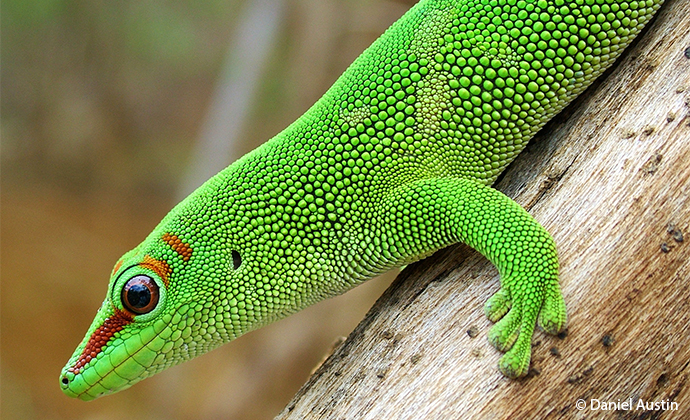
These gorgeously coloured lizards spend their days hunting insects, and will occasionally supplement their diet with nectar, pollen or fruit.
Satanic leaf-tailed gecko
Day geckos are extremely unusual both in being day-active and in exhibiting such eye-catching markings. Nearly all other geckos are nocturnal, with skin in shades of brown or greenish-grey to help them blend in with their natural surroundings. And none is more expert at camouflage than the leaf-tailed geckos of the Uroplatus genus found in Madagascar.
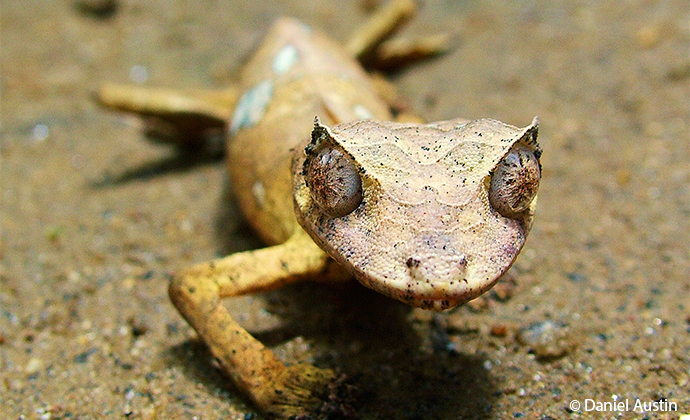
When at rest by day, so well do they blend in with the surrounding leaves or bark that local forest guides frequently have difficulty convincing their clients that there’s an animal there at all, even when it is right under their nose! The one in this photo is only so obvious because it is on a background of sand rather than the dead leaves amongst which it usually prefers to rest. This species has perhaps the most wonderful scientific name of the 18 so far described: Uroplatus phantasticus. In English, it is known as the satanic leaf-tailed gecko thanks to those little horns above its eyes.
Madagascar paradise flycatcher chicks
This pair of hungry beaks belongs to a couple of young Madagascar paradise flycatchers. To give you some idea of their scale, that nest would just about accommodate a golf ball.
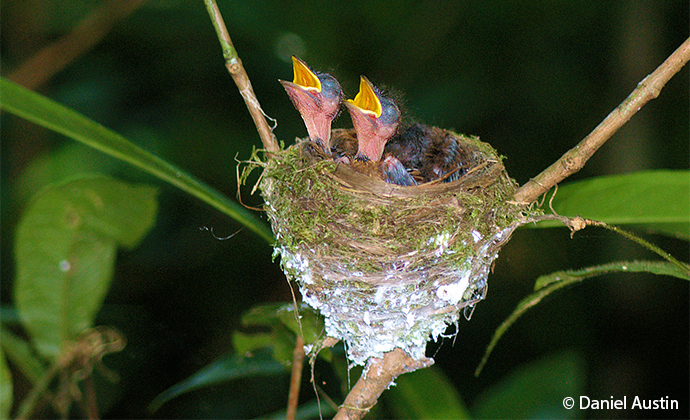
The paradise flycatchers are – perhaps unsurprisingly for a bird with such a name – rather glamorous birds when they reach adulthood. The males occur in two distinct morphs – orange and blue or black and white – both forms sporting a vivid blue eye-ring and a long tail with which to show off to females.
Giraffe-necked weevil
When I said that Madagascar has no giraffes, that was only a half-truth. The country’s most famous insect (thanks to David Attenborough’s natural history documentaries) is the giraffe-necked weevil, so named for obvious reasons. Rather like real giraffes, the males use their ridiculously long necks to fight over females.
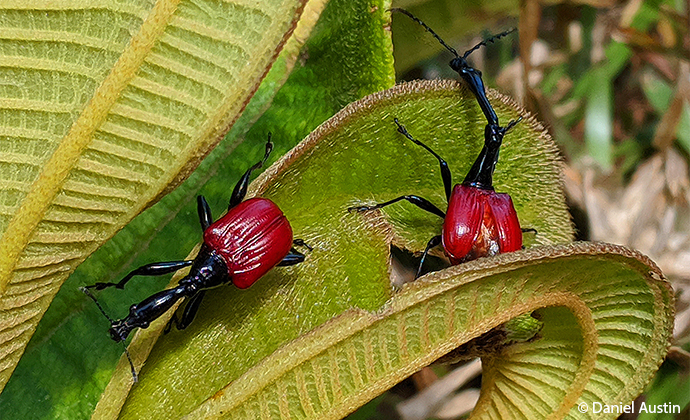
Unlike their eponymous Brobdingnagian friends in Africa, though, these extraordinary red-and-black beetles also possess the ability of flight. How they manage to keep their balance while doing so, and avoid tumbling upside-down, is anybody’s guess.
Trio of froglets (Madagascar reed frog)
When I first visited Madagascar in the early 2000s, there were around 180 frog species known to exist on the island, virtually every last one of them endemic. Since then, that number has doubled and herpetologists expect it to double again by the time they’re done describing new species. It just goes to show how much is still unknown in Madagascar. Over the past couple of decades, scientists have been naming new Malagasy frog species at the incredible rate of one every five weeks, on average.
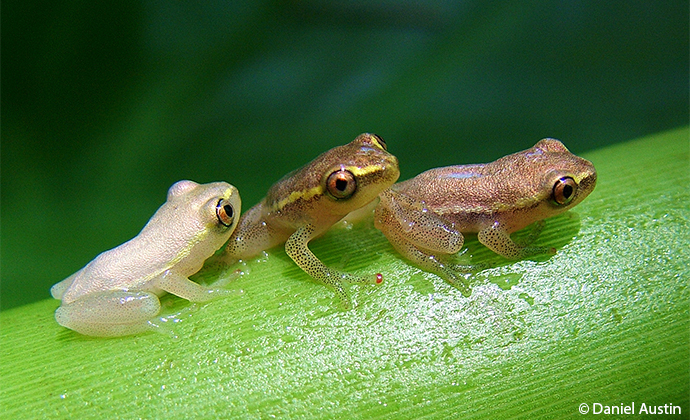
The frogs in this photo are youngsters, less than half of their adult size, but even as adults the majority of Madagascar’s frogs are rather small, as frogs go. Earlier this year, a new genus of particularly tiny frogs was described under the name Mini. There are currently three species, all with tongue-in-cheek scientific names: Mini scule, Mini mum, and Mini ature!
Boophis pyrrhus calling
Boophis pyrrhus, with a species name meaning fire-red, was described in 2001. It is one of many colourful frogs that can be easily seen in the island’s rainforest national parks.
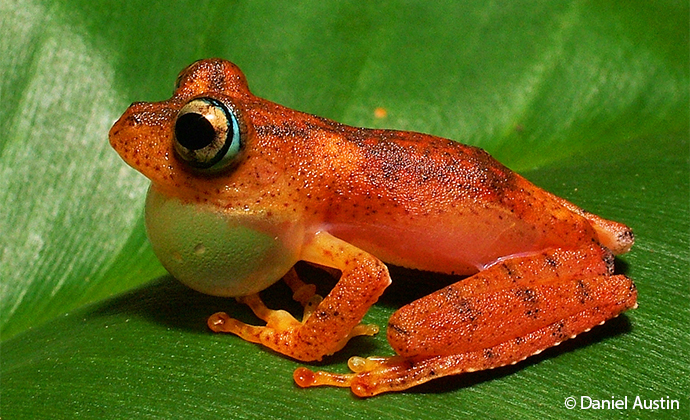
I photographed this male calling one evening at the Analamazaotra Forest in Andasibe-Mantadia National Park, half a day east of the capital city. It’s surprisingly challenging getting a shot of a frog calling. They’re easy to hear, but not always as easy to locate by following the sound as you might think. And then they tend to fall silent when you get too close. This individual, though, was being unusually cooperative. That said, they do prefer to call from leaves that overhang water, so I had to stand in a shallow stream to get the shot! Wildlife photography can be a labour of love sometimes.
Giant Madagascar jumping rat
You would be forgiven for not rushing to put a ‘giant rat’ at the top of your wildlife bucket list, even an endangered one, but hear me out. Forget rats, the giant Madagascar jumping rat is more like a cross between a rabbit and a kangaroo. For starters, they are rabbit-sized and live underground in warren-like burrows with as many as half a dozen entrances. They are nocturnal and, very unusually for rodents, monogamous. When they emerge at night, they often move around by using their long muscular back legs to bounce along in a rather kangaroo-like fashion.
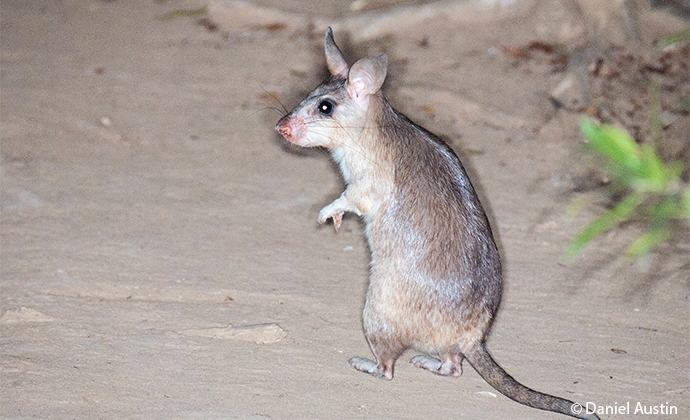
Like more than 80% of flora and fauna in Madagascar, they are endemic to the island. In fact, they are endemic not just to the island but to one single forest no bigger than 15km by 15km. What’s more, it’s a forest that’s under threat of destruction, which is why they are considered an endangered species.
Rainbow milkweed locusts mating
These large and colourful locusts feed on toxic milkweed plants (also known as spurge or Euphorbia), which makes the insects toxic themselves.
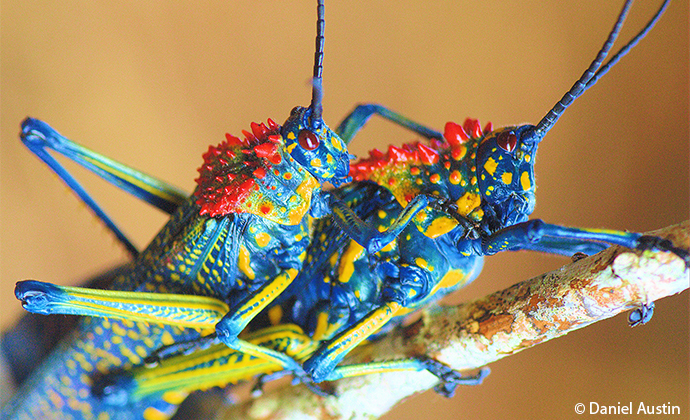
Their bright colouration is an example of what is known as aposematism – an advertisement to potential predators of their toxicity. Young locusts of this species are orange and black, becoming red, yellow and blue with development.
Nosy Be spiny orb-weaver spider
No list of Madagascar’s incredible mini-beasts would be complete without a mention of spiders. The island is home to strange and beautiful species, many fascinating enough to make even an arachnophobe look closer. People think they know about spiders; they think spiders sit in the middle of circular webs waiting for flies. And it’s true, a few do. But there’s nearly 50,000 species of spider in the world, playing every role imaginable.
In Madagascar, besides the web designers, there are fishermen that can walk on water; hunters which prowl in search of their prey; glitzy disco queens whose bodies are like tiny mirror balls, covered in silver sequins; thieves who sneak into other spiders’ webs to steal their food; pilots that can fly by releasing fine silk threads that catch the breeze in a process known as ‘ballooning’; squatters who move into discarded snail shells that they winch up into overhanging vegetation; trapeze artists that hang by their back legs from a pair of threads and swing to catch passing moths; net-throwers which construct elasticated nets that they throw over any insect that ventures too close; and cannibals specialised in assassinating fellow spiders.
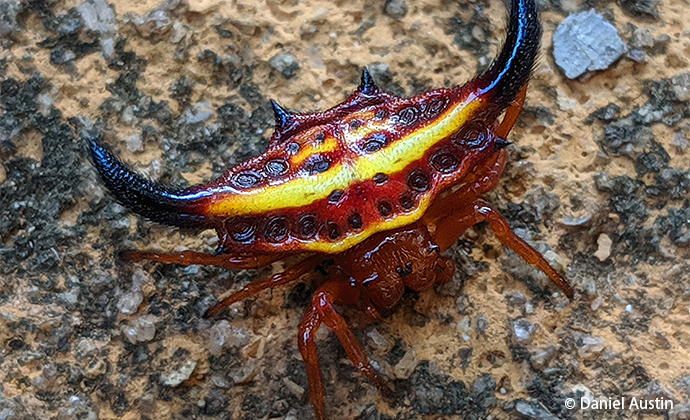
And that’s just the tip of the iceberg. Spitting spiders spit liquid silk; bird-dropping spiders tempt flies closer by looking and smelling like poo; bolas spiders swing a lasso to ensnare flying moths; intertidal spiders have adapted to live only between the low and high tide lines on the coast; pirate spiders pluck the strands of other spiders’ webs, mimicking a trapped insect to lure the resident out and attack them; jumping spiders have big puppy-dog eyes with excellent vision; crab spiders lay in ambush on flowers and fruit; and trapdoor spiders lurk in lidded burrows, lunging out when a tripwire is disturbed.
Golden orb-weaver spiders build huge webs of strong silk that can, with great patience, be woven into fabric (Queen Victoria was the recipient of a pair of Malagasy spider silk stockings). And Darwin’s bark spiders spin silk that is stronger still – the strongest biological material yet discovered, in fact – allowing them to build the world’s biggest webs across spans of up to 25m.
Three-eyed lizard
The three-eyed lizard is the smallest of the Malagasy iguanas. They are a ground-dwelling species generally found on sandy substrates, where they move around at speed to avoid being eaten by snakes and birds.
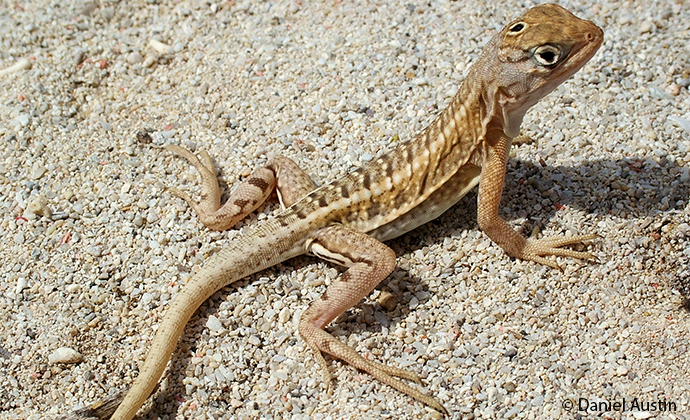
The name refers to that black dot on top of its head, and it’s not just a mark; it really is a third eye – of sorts. It is known as a pineal eye. Although this eye cannot see in the real sense of the word, it is sensitive to light and dark, and contains a primitive lens and retina. It is thought that it may react to sunlight in order to regulate the animal’s daily rhythm.
Coiled millipedes
It was 15 years ago during a hike in the northwest of Madagascar that, just as I was about to duck under a branch, I noticed a beautiful striped millipede resting on the underside. On closer inspection, I realised that it was in fact a pair of millipedes, coiled together symmetrically. Photographing upwards, backlit against a bright sky, conditions were not ideal for photography, but I did manage to get this shot.
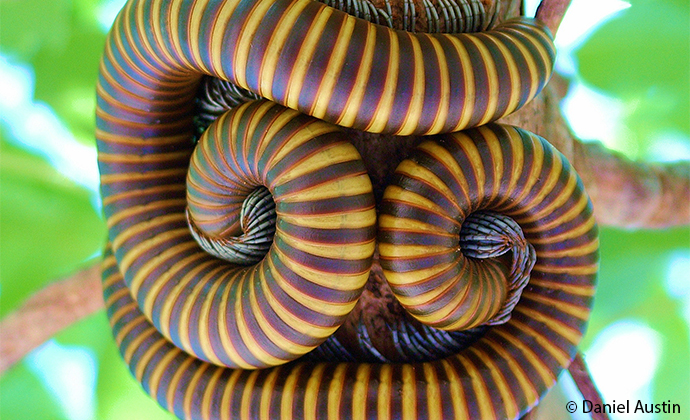
Never again since that day have I seen millipedes interacting like this. They are not mating (a giant millipede’s genitalia are just behind its head, so they tend to mate face to face), but whether this is a courtship behaviour, I really have no idea.
Young radiated tortoise
Madagascar is home to a number of tortoise and turtle species, including this critically endangered radiated tortoise. They can reach more than 40cm in length and 16kg in weight – and close to 200 years of age – so this one pictured at Cap Sainte Marie Special Reserve, in the far south of Madagascar, is a mere baby.
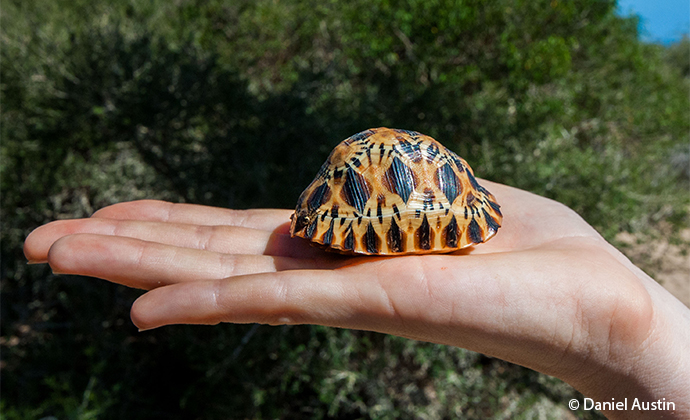
Also endemic to Madagascar is the world’s rarest tortoise: the ploughshare tortoise. In the 1980s, the wild population was estimated to have dropped below 400 individuals. By 2005, thanks in part to a breeding programme run by Durrell Wildlife Conservation Trust, that total rose to a marginally healthier 800 or so. Since then, however, there has been a marked increase in poaching (owing to their extreme rarity, they fetch as much as £45,000 each on the Asian black market) and numbers are thought to be as low as 100 now.
Fossa
This is a fossa. It weighs about 7kg fully grown. It’s Madagascar’s largest carnivore – which just goes to prove how diminutive Malagasy fauna is compared with the beasts that roam the plains of Africa.
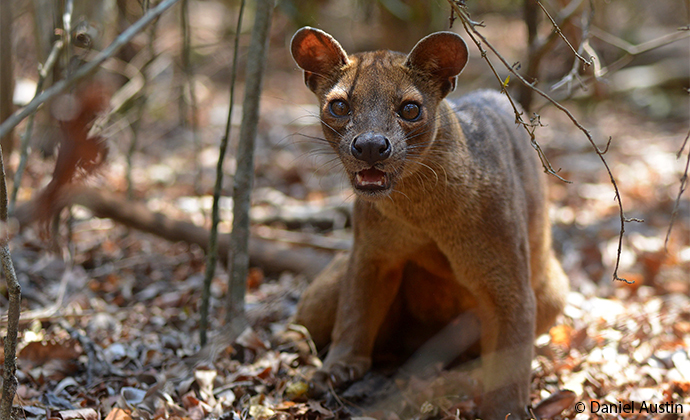
Despite its feline appearance, the fossa is a distant relative of mongooses and hyenas, not a cat at all. They have semi-retractable claws and flexible ankles that allow them to climb both up and down trees head-first (unlike most cats) – and they can do it at lightning speed in pursuit of lemurs, their main prey.
Male fossas are notable for possessing the largest penis, by proportion of body size, of any mammal. This member is supported by a baculum – or penis bone – and it needs to be because they mate for around three hours straight. The female has even more stamina, as she often mates with several males in a row, sometimes for as long as 14 hours in total.
Visit www.danielaustin.co.uk for more about Daniel or follow @danielaustin_wildlife on Instagram. For more on Madagascar, take a look at his comprehensive guide: